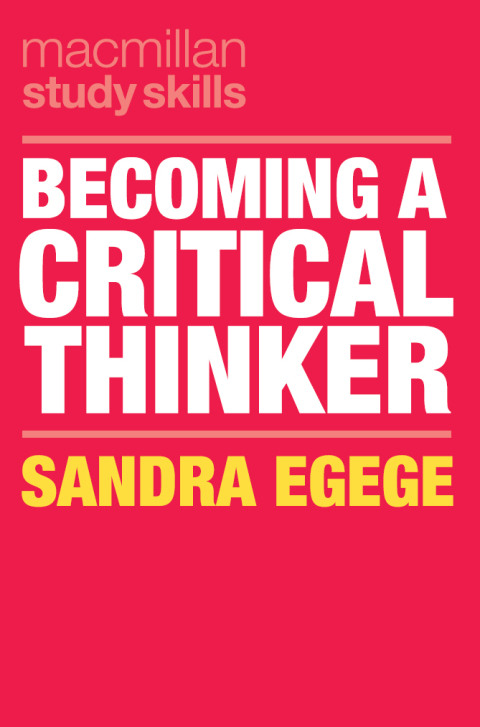Description
Efnisyfirlit
- Cover
- Half-Titlepage
- Seriespage
- Titlepage
- Copyright
- Contents
- Foreword
- Glossary
- Chapter 1 Why Critical Thinking Matters: Research, Knowledge and Epistemology
- Why critical thinking matters
- The importance of critical thinking
- So what is the critical thinking process?
- Research
- The process of research
- What is knowledge?
- Knowledge claims or statements
- Justification
- What counts as proof or evidence?
- Knowledge and epistemology
- Chapter summary
- Answers to Exercises 1–3
- Chapter 2 Overcoming Barriers – Cognitive Biases
- How do we know that x is true?
- True or false beliefs?
- Barriers to knowledge – false beliefs, fake news and personal bias
- What is cognitive bias?
- Confirmation bias
- Belief preservation
- Why preserve or perpetuate a false belief?
- How do we know if we are biased?
- We are living in a post-truth era!!
- Relevance to academic study and life
- Chapter summary
- Answers to Exercises 1-3
- Chapter 3 Overcoming Barriers – Problems with Perception
- Epistemology and perception
- Scepticism about knowledge
- Problems with perception – observation
- The bent stick
- The Necker Cube – inside/outside
- Perspective matters: how perceptions influence our beliefs
- Beliefs matter: how our beliefs can influence our perceptions
- Making observation more reliable
- How do we know that we know?
- Our limitations can be addressed
- Chapter summary
- Answers to Exercises 1–2
- Chapter 4 Knowledge Claims – Recognising and Writing an Argument
- Knowledge claims and justification
- Why and when to use argument
- What is an argument?
- Persuasive writing and identifying an argument
- Explanation or argument?
- Argument structure and argument mapping
- Important point
- Chapter summary
- Answers to Exercises 1–4
- Chapter 5 Critiquing the Logic of the Argument – Logical Thinking and Common Fallacies
- Knowledge, justification and logic
- Assessing arguments
- Types of justification for arguments
- Inductive reasoning
- Strength and limitations of inductive arguments
- Problems with inductive reasoning
- Deductive reasoning
- Example of a deductive inference and argument
- Strength and limitations of deductive arguments
- Logical fallacies
- Chapter summary
- Answers to Exercises 1-6
- Chapter 6 Critical Thinking and Digital Literacy: Evaluating the Information Source
- The need for digital (information) and critical literacy
- How reliable is the information we have access to? What can we trust?
- Becoming a more effective critical thinker (and writer)
- How do you check for credibility?
- Does it matter if it is wrong?
- What does verification mean?
- Accredited fact checkers
- Seek disconfirmation
- Digital information literacy: critiquing web sources for credibility
- Assessing credibility
- Can I use Wikipedia? Is it reliable?
- Evaluating information sources for academic purposes
- Credible sources – accessing reliable academic sources
- Chapter summary
- Answers to Exercises 3–4
- Chapter 7 Critiquing the Literature – How Do You Know That Is So?
- Academic texts and critical thinking
- Reading academic articles
- Critical reading
- Reviewing (critiquing) an academic article
- Sets of criteria for evaluating and critiquing an academic article
- Writing the review
- Chapter summary
- Answers to Exercises 1–2
- Chapter 8 Critiquing the Evidence: Quantitative and Qualitative Research Methodologies
- Critiquing the evidence
- Types of evidence
- The research process
- Critiquing or evaluating causal justification
- Setting up a (scientific) experiment
- Quantitative and qualitative research methodologies
- Mixed methods
- Critiquing quantitative (research) data
- Be cautious with statistics; learn what they mean
- Critiquing qualitative research
- Rigour and reliability
- Chapter summary
- Answers to Exercises 1–7
- Chapter 9 Writing an Argument – Making It Persuasive
- Critical thinking and writing a convincing argument
- What makes a good/strong argument?
- How do I write a persuasive argument?
- What counts as enough evidence?
- What can we infer?
- Qualifying our claims
- Using inference indicators
- Other useful discourse markers
- Providing balance and avoiding contradictions
- Logical structure of ideas
- Chapter summary
- Answers to Exercises 1–7
- Chapter 10 Writing (Critical) Literature Reviews
- Addressing ‘the literature’
- Types of literature reviews
- Writing a literature review
- Most common complaints from lecturers and thesis examiners
- Choosing the right critical language
- Sample review
- Chapter summary
- Answers to Exercise 1
- Chapter 11 Critical Thinking as Critical Self-Reflection
- Thinking critically about oneself
- Having a critical thinking disposition
- The need for critical self-reflection
- Self-reflective practice in nursing
- Self-reflective practice in social work
- Self-reflective practice in education
- Critical thinking and the role of a self-reflective journal
- Chapter summary
- Answers to Exercises 1–7
- Chapter 12 Critical Thinking in the Workplace
- The complexity of work-life in the contemporary world
- Critical thinking as a future skill-set
- Relevance to employment
- Public/civil service and government
- Industry and business
- Chapter summary
- Answers to Exercises 1–4
- References
- Index







Reviews
There are no reviews yet.